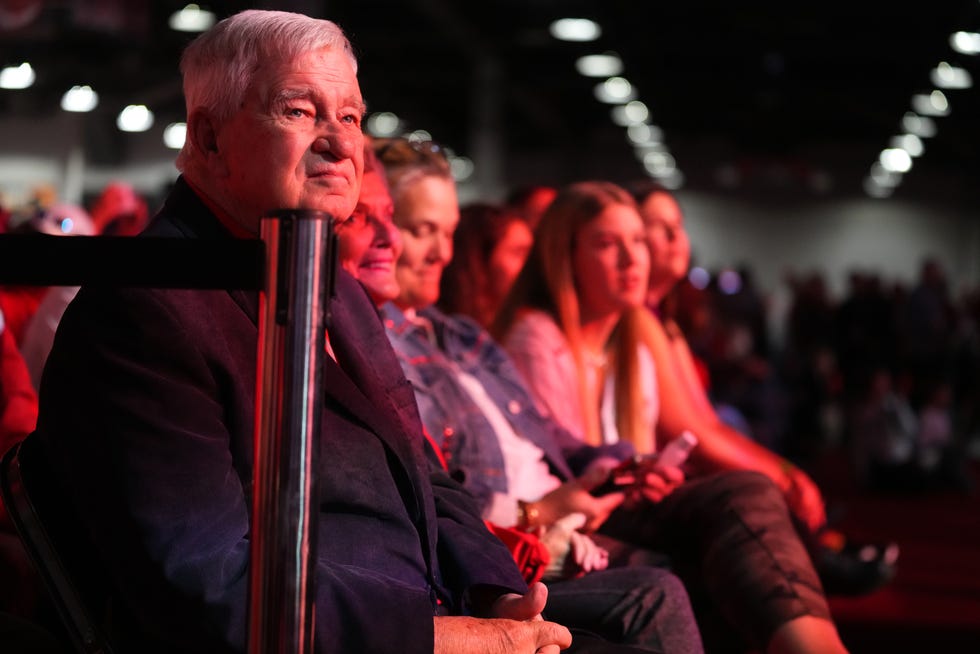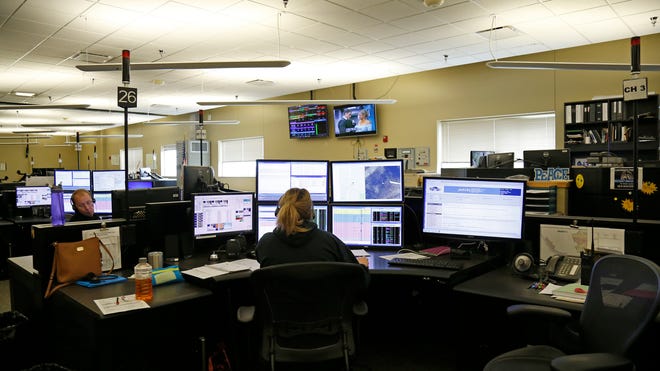An unusually powerful storm battered the Hawaiian islands Tuesday, leaving thousands without power and flooding streets across the archipelago.
The dangerous weather left tourists stranded, including several who canceled wedding plans, and some of the islands' most iconic beaches barren as the threat of dangerous flash floods, landslides and crashing tree limbs persisted. It also brought as much as 8 inches of snow atop some of the state's highest summits. The conditions forced Gov. David Ige to issue a state of emergency for all of the state’s islands Monday night.
Honolulu firefighters made about 90 rescues during the storm, including helping five children ages 9 and 10 in a raging creek. They also rescued an elderly woman trapped in a room by floodwaters, the fire department told Hawaii News Now.
“The entire home was later evacuated after a side wall of the house had collapsed from the flooding water around their home,” the department told the news outlet.
The storm's severe conditions were forecast to continue throughout the day Tuesday, bringing heavy rain and strong wind gusts to the state's most populated island of Oahu, the National Weather Service said. Forecasters say the storm should move offshore Wednesday and allow for drier conditions the rest of the week.
The storm, which brought at least a foot of water in some areas and allowed for forecasts of up to 100 mph wind gusts atop some of the island's summits, knocked out power for about 4,500 people as of Tuesday morning, according to PowerOutage.us.
On Oahu, where four shelters had been opened, most of the beaches in Waikiki were empty Monday as only a few people walked with umbrellas during passing heavy showers. Roadways were flooding in the area and cars crept through downtown as water gushed out of manhole covers. Photos on social media of the state's most populated island showed debris floating down flooded streets and water rising up to the headlights of cars.
State of emergency declared:Forecasters warn of 'catastrophic' flooding

On Maui, power outages and flooding were reported, with more than a foot of rain falling in some areas. The southern shores of Maui recorded at least 11.28 inches.
The relentless rain forced three couples from the U.S. mainland to postpone their Maui wedding plans, said Nicole Bonanno, owner of Bella Bloom Floral, a wedding florist and boutique in Wailea. The weather also led to delayed flower deliveries, a lei company with no power and employees braving flooded roads littered with debris, Bonanno said.
“The roads, everything are a mess,” she said. “There are lots of trees down.”
Veterans and survivors of the attack on Pearl Harbor 80 years ago planned to meet for the anniversary celebration Tuesday morning at Pearl Harbor. Navy spokesperson Brenda Way told The Associated Press in an email Monday that she has heard of no discussion of canceling the event because of the storms.
Pearl Harbor remembered:Pearl Harbor 'led to a changed world.' 80 years later, a fading memory will be honored again.
The unusually dangerous storm is known as a Kona low, a type of seasonal cyclone that can occasionally impact the Hawaiian Islands during the winter months. They form from winds coming from the westerly "Kona" direction and can bring heavy rains to areas that don't typically see those conditions in other times of the year, the weather service said.
“There is the potential for up to a foot of rain to fall on Honolulu with an AccuWeather Local StormMax of 40 inches possible for the south- and southwest-facing mountainsides of the islands,” AccuWeather meteorologist Alex Sosnowski said, noting the impacts would continue on Oahu and Kauai through much of Tuesday.
Along with the rain, the storm caused up to 90 mph wind gusts and a blizzard warning over the weekend for the state’s highest peak on the Big Island.
Snow is not rare at the summit of Mauna Kea, which is nearly 14,000 feet high, and the last blizzard warning was in 2018. No residents live at the summit, but there are telescope observatories and other offices where officials work.
The weather service said there were reports of 8 inches of snow on the road below the top of Mauna Kea and officials were working to get there to measure. Up to a foot of snow was forecast.
The summit also recorded gusts of about 90 mph. Other areas saw strong gusts of more than 50 mph.
Bizarre lows were also recorded, with Honolulu failing to reach 70 degrees on Saturday and Sunday — the first time all year. The city saw a record low of 56 degrees, according to AccuWeather.
Contributing: Associated Press










